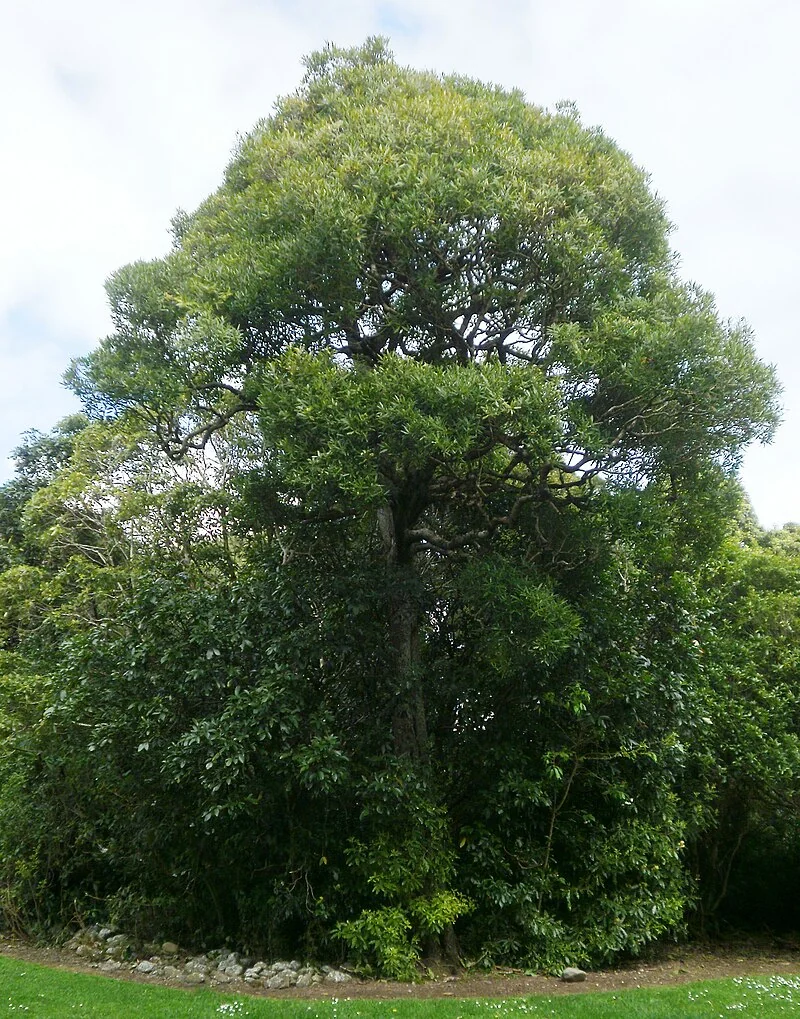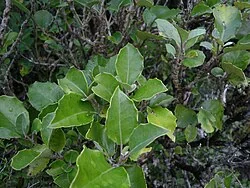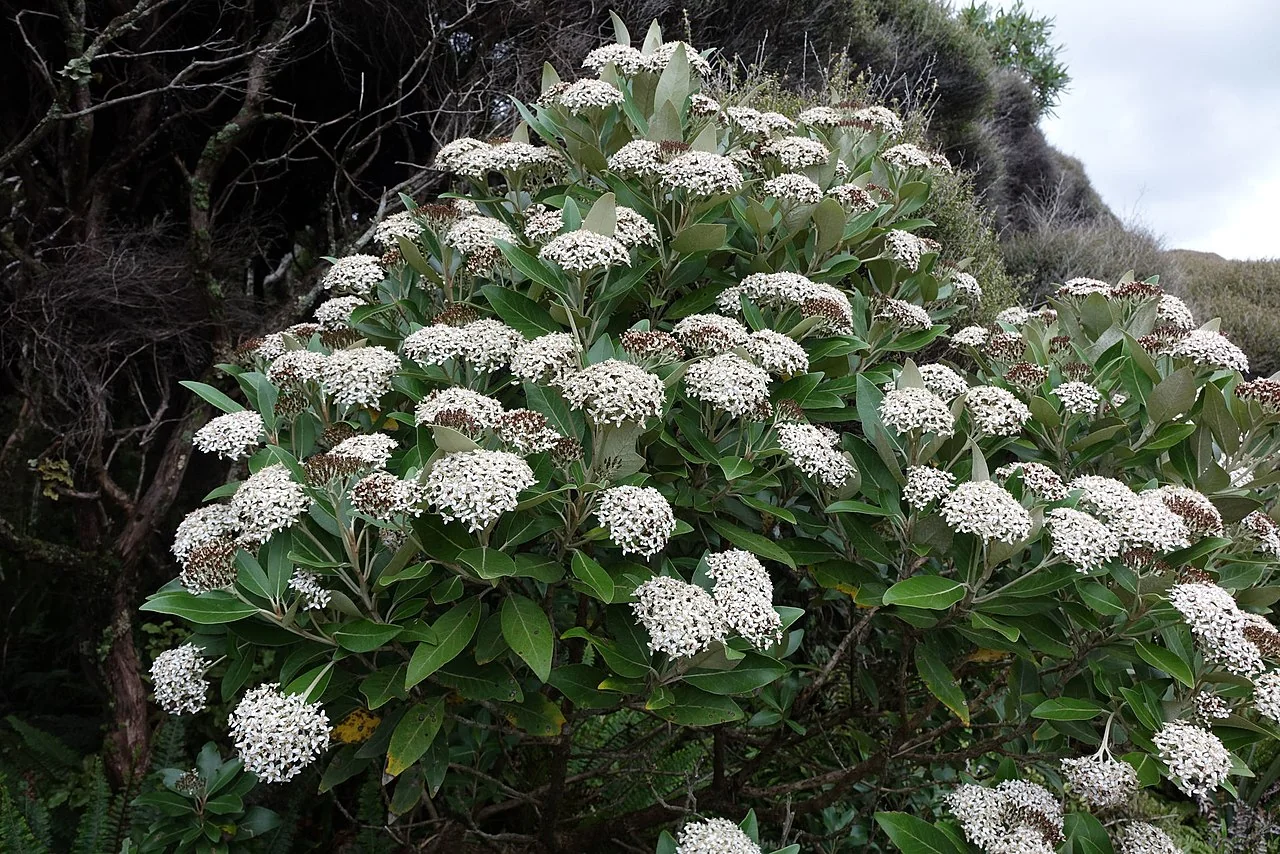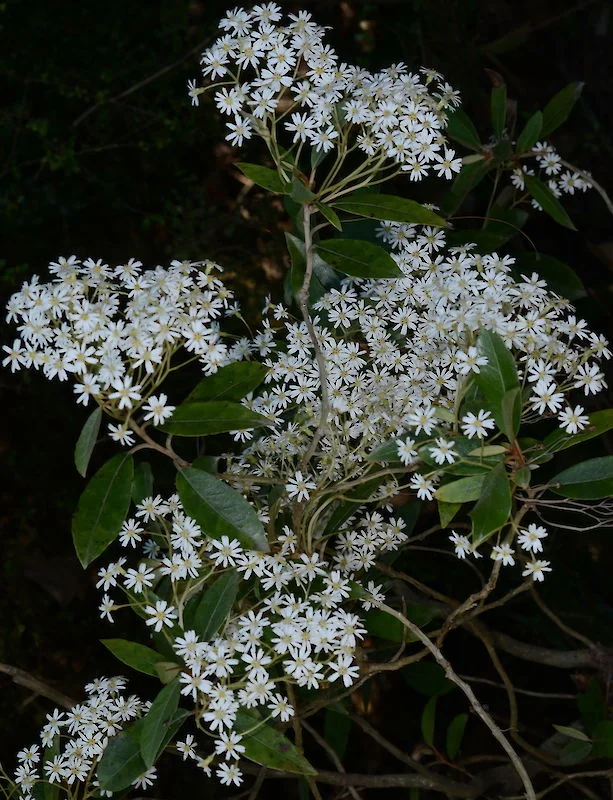
Black Maire
Nestegis cunninghamii
Black Maire ( Nestegis cunninghamii ) is a majestic native New Zealand tree, celebrated for its exceptionally hard, dark timber and its dense, glossy green foliage. This large evergreen tree is endemic to the North Island and northern South Island, typically found in lowland and montane forests. Its impressive stature and durable wood make it a valuable species for native forest restoration projects and a striking specimen tree for larger native plant gardens. Black Maire is a resilient and ecologically important tree that adds a touch of primeval grandeur to any landscape, showcasing the ancient lineage of New Zealand's forests. For related species, see the native plants index.

Plant Description
Botanical Features
Black Maire (Nestegis cunninghamii) is a native evergreen tree of New Zealand, growing to impressive heights of over 20 meters, with a trunk up to 1.5 meters in diameter. The tree is characterized by its rough, corky bark, which often has a square-patterned or tessellated appearance. Its leaves are dark green, long, narrow, and leathery, typically arranged in opposite pairs. Adult leaves measure 7-15 cm in length and 1.5-4.5 cm in width, with a pronounced recessed or sunken midrib on the upper surface and clearly visible veins on the pale green underside. Juvenile leaves are notably longer and very thin, reaching 15-25 cm. It produces small flowers, 3-5 mm in diameter, with four green petals. These develop into striking red or yellow drupes (fruits) that are 1-2 cm long and contain a single hard seed. Fruiting typically occurs from December to April.
Quick Facts
| Scientific Name | Nestegis cunninghamii |
|---|---|
| Common Name | Black Maire, Large-leaved Maire |
| Family | Oleaceae |
| Height | Up to 20 m |
| Spread | Up to 8 m |
| Light | Partial shade to full shade |
| Soil | Moist, well-drained, fertile soils |
| Water Needs | Moderate to high |
| Frost Tolerance | Moderate |
| Salt Tolerance | Low |
| Growth Rate | Medium |
| Lifespan | Long |
Climate Best Suited to
Black Maire ( Nestegis cunninghamii ) is native to the North Island and northern South Island of New Zealand, typically found in lowland and montane forests. It thrives in mild, temperate climates with high humidity and consistent rainfall. It prefers sheltered locations, protected from strong winds and harsh frosts. Its natural habitat includes forest understoreys and damp gullies, indicating a preference for cooler, shadier conditions. It can be successfully cultivated in similar temperate regions, provided it has good drainage and protection from extreme heat or prolonged severe frosts when young.
Regional Suitability
| City | Climate Suitability |
|---|---|
| Whangārei | Ideal |
| Auckland | Ideal |
| Hamilton | Ideal |
| Tauranga | Ideal |
| Rotorua | Ideal |
| Gisborne | Ideal |
| New Plymouth | Ideal |
| Napier | Ideal |
| Whanganui | Ideal |
| Palmerston North | Ideal |
| Wellington | Ideal |
| Nelson | Ideal |
| Christchurch | Ideal |
| Dunedin | Ideal |
| Invercargill | Ideal |
Natural Habitat
Typical Environments
Understand the natural habitat of Black Maire ( Nestegis cunninghamii ), which is found throughout the North Island and northern South Island of New Zealand, in lowland and montane forests. This section details its geographical distribution, preferred environmental conditions, and the types of ecosystems where it naturally occurs.
- Widespread across the North Island and northern South Island.
- Found in lowland and montane forests, often in damp gullies and understoreys.
- Prefers sheltered sites with good air circulation.
- Thrives in partial to full shade.
Its broad habitat range highlights its adaptability and resilience, making it a fascinating subject for ecological study.
Plant Conservation
Nestegis cunninghamii, commonly known as black maire, is classified as "Not Threatened" in New Zealand. Despite its decline in numbers due to historical logging for its valuable timber and use as firewood, it is not currently considered threatened in its native New Zealand.
Black maire is endemic to New Zealand, found on the North, South, Hauturu (Little Barrier), and Aotea (Great Barrier) Islands. It is now most commonly observed in the main Axial Ranges and Central Volcanic Plateau of the North Island.
Growing Requirements
Soil Requirements
Black Maire prefers moist, well-drained, and fertile soils. It naturally grows in humus-rich forest soils. Amend heavy soils with compost or other organic matter to improve drainage and fertility. A neutral to slightly acidic pH is ideal. Ensure consistent moisture, especially during dry periods.
- Prefers moist, well-drained, fertile soils.
- Benefits from organic matter enrichment.
- Ideal pH: neutral to slightly acidic.
- Avoid waterlogged conditions.
Light Requirements
Black Maire thrives in partial to full shade, especially when young. It is sensitive to direct, harsh sunlight, which can scorch its leaves. Plant it in a sheltered spot under larger trees or on the shaded side of a building where it receives dappled light or indirect sun throughout the day. Mature trees can tolerate more sun if kept moist.
- Prefers partial to full shade, especially when young.
- Avoid direct, harsh sunlight.
- Ideal for underplanting or sheltered positions.
Water Requirements
This tree requires consistent moisture, especially during dry periods and its establishment phase. The soil should be kept moist but not waterlogged. Regular watering is crucial for healthy growth and abundant fruiting. Reduce watering slightly during cooler winter months.
- Requires consistent moisture.
- Keep soil moist, but ensure good drainage.
- Water more frequently during dry spells.
Planting Guide
Best Time to Plant
The best time to plant Black Maire is during autumn or spring, when temperatures are mild and rainfall is more consistent. This allows the tree to establish its root system before the extremes of summer heat or winter cold.
Choosing a Location
Select a site with partial to full shade and moist, well-drained, fertile soil. Black Maire is ideal for planting in the understorey of larger trees, in sheltered garden beds, or as a specimen tree in a protected location. Ensure it has adequate space for its mature size.
Planting Steps
- Dig a hole twice the width of the root ball and the same depth.
- Gently remove the tree from its container, being careful not to disturb the roots.
- Place the tree in the hole, ensuring the top of the root ball is level with the surrounding soil.
- Backfill with amended soil, firming gently around the base of the tree.
- Water thoroughly immediately after planting to settle the soil.
- Apply a layer of organic mulch to help retain moisture and suppress weeds, keeping it away from the trunk.
Initial Care
Water regularly during the first 6-12 months to help establish a strong root system. Once established, Black Maire is reasonably low maintenance and requires less frequent watering. Protect young trees from strong winds and severe frosts if necessary.
Ecological Role
Ecosystem Roles
The ecological importance of Black Maire ( Nestegis cunninghamii ) within its native New Zealand ecosystems is significant. Its berries provide a crucial food source for native birds, particularly during autumn and winter, aiding in seed dispersal and playing a key role in forest regeneration. Its dense foliage also provides shelter for small birds and invertebrates.
- Berries are a crucial food source for native birds.
- Aids in seed dispersal and forest regeneration.
- Provides shelter for small birds and invertebrates.
- Contributes to biodiversity in diverse forest ecosystems.
As an endemic species, it is an integral part of the unique biodiversity that has evolved in New Zealand, supporting the delicate balance of its natural habitats.
Uses and Significance
Garden Uses
- Excellent specimen tree for larger gardens.
- Suitable for native forest restoration and revegetation.
- Provides year-round interest with evergreen leaves.
- Attracts native birds to its berries.
Landscaping Applications
Black Maire ( Nestegis cunninghamii ) is a highly attractive and versatile tree for various landscaping applications, particularly in native and shaded gardens. Its graceful form and durable timber make it a valuable asset.
- Ideal as a specimen tree for larger gardens and parks.
- Excellent for native forest restoration and revegetation projects.
- Provides year-round interest with evergreen leaves.
- Suitable for mass plantings or as an accent plant.
Its ability to thrive in sheltered, shaded conditions and its aesthetic appeal make it a popular choice for creating lush and beautiful native landscapes.
Seasonal Care Calendar
Spring
New growth emerges, and inconspicuous flowers may appear. This is an ideal time for planting new Black Maire specimens or propagating from cuttings. Ensure consistent moisture for young trees and protect them from strong winds if necessary. A light feed with a balanced slow-release fertilizer can encourage vigorous growth.
- Ideal time for planting and propagation.
- Ensure consistent moisture for new trees.
- Light fertilization if needed.
Summer
Black Maire is actively growing and may produce flowers and developing berries. Consistent watering is crucial, especially during dry spells, to prevent stress. Monitor for pests and diseases, though it is generally quite resilient.
- Active growth and flowering.
- Consistent watering is essential.
- Monitor for pests and diseases.
Autumn
Berries ripen and become prominent in autumn, providing a valuable food source for native birds. This is another good time for planting, allowing roots to establish before winter. Minimal care is required for established trees, but ensure they remain adequately hydrated.
- Berries ripen, attracting birds.
- Good time for planting.
- Minimal care for established trees.
- Ensure adequate hydration.
Winter
Black Maire is evergreen and provides year-round interest. It is moderately frost-tolerant and requires minimal care during this period. Ensure good drainage to prevent root issues in wet conditions.
- Evergreen, provides year-round interest.
- Protect young trees from severe frost.
- Ensure good drainage.
When to Prune and How Much
Black Maire generally requires minimal pruning to maintain its natural form. The primary reason for pruning is to remove dead or damaged branches, or to shape the tree as desired. Its natural growth habit is often quite attractive, so extensive pruning is rarely needed.
- Remove dead or damaged branches as needed.
- Light shaping to maintain desired form.
- Best done in late winter or early spring before new growth.
- Use clean, sharp tools.
Avoid heavy pruning, as this can stress the tree. Allow it to develop its natural, graceful canopy.
How to Grow Black Maire
Black Maire is a majestic native New Zealand tree, celebrated for its exceptionally hard, dark timber and its dense, glossy green foliage. This large evergreen tree is endemic to the North Island and northern South Island, typically found in lowland and montane forests. Its impressive stature and durable wood make it a valuable species for native forest restoration projects and a striking specimen tree for larger native plant gardens. Black Maire is a resilient and ecologically important tree that adds a touch of primeval grandeur to any landscape, showcasing the ancient lineage of New Zealand's forests. Understanding its propagation methods is key to successfully growing this delightful species.
From Seed
Propagating Black Maire from fresh seed is a viable method, though germination can be slow and may require stratification. Collect ripe seeds in late autumn or early winter. Clean the seeds thoroughly to remove any fleshy pulp. Sow the seeds in a tray filled with a well-draining seed-raising mix, lightly covering them. The seeds typically require a period of cold stratification (e.g., refrigerate for 2-3 months) to break dormancy. Maintain consistent moisture in the seed tray and keep it in a warm, sheltered location. Germination can take several weeks to months after stratification. Once seedlings have developed a few true leaves, they can be potted into individual containers and grown in a sheltered environment before planting out.
From Cuttings
Semi-hardwood cuttings are a reliable method for propagating Black Maire, ensuring that new plants retain the exact characteristics of the parent. Take 10-15 cm cuttings from healthy, semi-hardwood stems in late summer or early autumn. Remove the lower leaves and dip the cut end in a rooting hormone. Insert the cuttings into a well-draining propagation mix (e.g., sand and perlite). Keep the cuttings in a warm, humid environment, out of direct sunlight, perhaps under a plastic dome or in a propagator. Rooting typically occurs within 8-12 weeks. Once rooted, the new plants can be potted on and grown in a sheltered environment until they are ready for planting.
Pests and Diseases
Black Maire is generally a robust tree, but it can be susceptible to certain pests and diseases, especially if not grown in optimal conditions.
Common Pests
- Aphids: Can infest new growth. Treat with insecticidal soap or remove manually.
- Scale Insects: May be present on stems and leaves. Treat with horticultural oil or appropriate insecticides.
Common Diseases
- Sooty Mould: Often associated with scale insect infestations, it can cover leaves and reduce photosynthesis. Address the underlying pest issue.
- Root Rot: Caused by overwatering or poor drainage. Ensure well-drained soil.
Good garden hygiene, proper watering, and adequate air circulation are key to preventing most pest and disease issues. Regular inspection will help catch problems early.
Cultural Significance
Nestegis cunninghamii, commonly known as black maire, holds significant cultural importance, particularly for Māori in New Zealand. Its dense and durable timber was highly valued and utilized for a variety of purposes.
Key Aspects of Its Cultural Significance Include:
- Tool and Weapon Construction: Māori extensively used black maire for making tools and weapons. This included wedges for splitting wood, k� (digging sticks), canoe paddles and bailers, beaters, mallets, and thin, double-pointed spears. Certain weapons like wahaika were also crafted from its roots.
- Construction and Domestic Uses: The timber was used for beams in storage houses and for constructing pā (fortified villages) stockades due to its durability and resistance to fire. It was also favored as a block when cutting greenstone and sometimes used as weights on drill shafts. For domestic purposes, all species of maire were used to make smokeless and long-lasting torches for lighting houses.
- Other Implements: Black maire was used for wooden spades, various digging sticks (hoto, k� , kaheru, pere, tipi), and even for making roria (jew's harp). Historical records also indicate its use for making toboggans and occasionally pahu (gongs).
- European Uses: Early European settlers also recognized the value of black maire timber, using it for caulking mallets, mauls, wheel or shaft bearings, and as framing for railway carriages, fencing, and bridge building materials. It was also used in cabinet making and turnery.
- Firewood: Black maire is considered one of the best indigenous timbers for firewood.
- Modern Uses: In recent years, the limited quantity of black maire available has been used for high-value turnery, such as golf putters and parts for flutes and bagpipes, due to its unique properties.
While Māori did not use black maire for medicinal purposes, its timber was highly regarded for its strength and durability. The fruit of the black maire was also eaten by Māori. The tree is considered a culturally significant species that adds both beauty and heritage value to New Zealand landscapes.
Bonus Tip
Black Maire is renowned for its incredibly dense and durable timber, which was highly valued by Māori for weapons and tools, and by early European settlers for railway carriage framing. Its timber is so dense that only Southern Rātā is heavier among New Zealand species, and it's considered one of the finest turning timbers.







